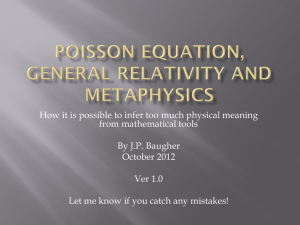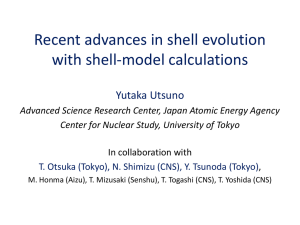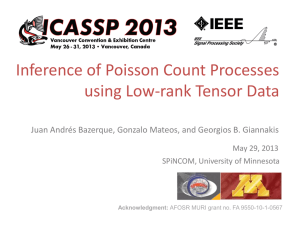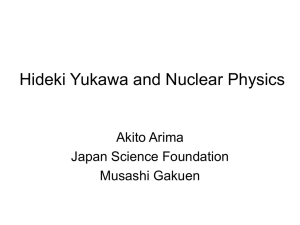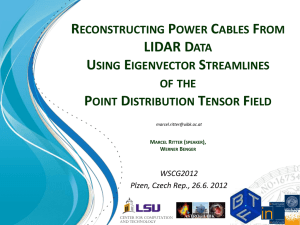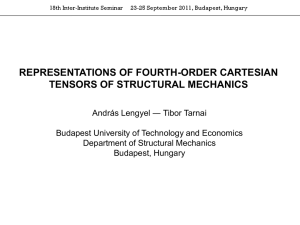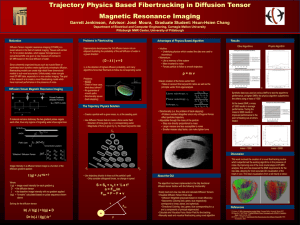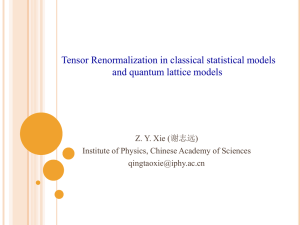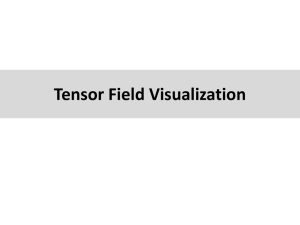Problems and Ideas at the Dawn of Three
advertisement
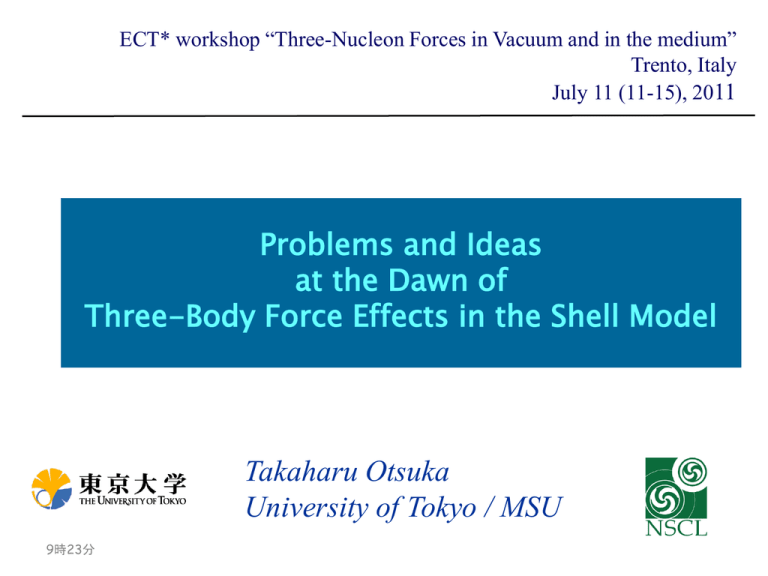
ECT* workshop “Three-Nucleon Forces in Vacuum and in the medium” Trento, Italy July 11 (11-15), 2011 Problems and Ideas at the Dawn of Three-Body Force Effects in the Shell Model Takaharu Otsuka University of Tokyo / MSU 9時23分 Outline 1. Monopole problem in the shell model 2. Shell evolution in exotic nuclei 3. Solution by three-body force Introduction to talks by J. Holt, A. Schwenk and T. Suzuki Spectra of Ca isotopes calculated by most updated NN interaction microscopically obtained By Y. Tsunoda and N. Tsunoda N3LO Vlow-k with L=2.0 fm-1 2nd and 3rd order Q-box 4hw and 6hw s.p.e. used Present GXPH1A KB3G GXPF1A for comparison KB3G Two-body matrix elements (TBME) may be calculated to a rather good accuracy 40Ca core is not very stable yet -> 0+ energy lowered 48Ca As N or Z is changed to a large extent in exotic nuclei, the shell structure is changed (evolved) by • Monopole component of the NN interaction Averaged over possible orientations Linearity: Shift nj’ : # of particles in j’ <nj’ > can be ~ 10 in exotic nuclei -> effect quite relevant to neutron-rich exotic nuclei Strasbourg group made a major contribution in initiating systematic use of the monopole interaction. (Poves and Zuker, Phys. Rep. 70, 235 (1981)) T=1 monopole interactions in the pf shell GXPF1A G-matrix (H.-Jensen) Tensor force (p+r exchange) Basic scale ~ 1/10 of T=0 What’s this ? j = j’ j = j’ Repulsive corrections to G-matrix T=1 monopole interactions in the sd shell SDPF-M (~USD) G-matrix (H.-Jensen) Tensor force (p+r exchange) Basic scale ~ 1/10 of T=0 Repulsive corrections to G-matrix j = j’ j = j’ T=0 monopole interaction The correction is opposite ! T=0 monopole interactions in the pf shell Tensor force (p+r exchange) GXPF1A G-matrix (H.-Jensen) f-f p-p f-p “Local pattern” tensor force T=0 monopole interactions in the pf shell Tensor force (p+r exchange) GXPF1A shell-model int. G-matrix (H.-Jensen) Tensor component is subtracted Correction is attractive Outline 1. Monopole problem in the shell model 2. Shell evolution in exotic nuclei 3. Solution by three-body force Treatment of tensor force by V low k and Q box (3rd order) Monopole component of tensor interactions in pf shell Bare (AV8’) short-range correlation by V low k in-medium correction with intermediate states (> 10 hw, 3rd order) only for comparison Systematic description of monopole properties of exotic nuclei can be obtained by an extremely simple interaction as Parameters are fixed for all nuclei monopole component of tensor force in nuclear medium almost equal ? monopole component of tensor force in free space Shell evolution due to proton-neutron tensor + central forces Changes of single-particle properties due to these nuclear forces T=1 NN interaction more relevant to ls splitting change exotic nucleus with neutron skin stable nucleus proton neutron r dr/dr ls splitting smaller From RIA Physics White Paper Neutron single-particle energies at N=20 for Z=8~20 p3/2 low energy (MeV) Z 14 8 20 16 solid line : full VMU (central + tensor) dashed line : central only Tensor force makes changes more dramatic. 16 20 These single-particle energies are “normal” f7/2-p3/2 2~3 MeV N=20 gap ~ 6 MeV d5/2 s1/2 more exotic d3/2 Z PRL 104, 012501 (2010) 2+ level (MeV) Increase of 2+ excitation energy Neutron number Outline 1. Monopole problem in the shell model 2. Shell evolution in exotic nuclei 3. Solution by three-body force Proton number Nuclear Chart - Left Lower Part - Why is the drip line of Oxygen so near ? Neutron number Single-Particle Energy for Oxygen isotopes by microscopic eff. int. G-matrix+ core-pol. : Kuo, Brown V low-k : Bogner, Schwenk, Kuo by phenomenological eff. int. - G-matrix + fit SDPF-M Utsuno, O., Mizusaki, Honma, Phys. Rev. C 60, 054315 (1999) USD-B Brown and Richter, Phys. Rev. C 74, 034315 (2006) trend What is the origin of the repulsive modification of T=1 monopole matrix elements ? The same puzzle as in the pf shell A solution within bare 2-body interaction is very unlikely (considering efforts made so far) Zuker, Phys. Rev. Lett. 90, 042502 (2003) 3-body interaction The clue : Fujita-Miyazawa 3N mechanism (D-hole excitation) D particle p m=1232 MeV S=3/2, I=3/2 D p Miyazawa, 2007 N N N Renormalization of NN interaction due to D excitation in the intermediate state D T=1 attraction between NN effectively Modification to bare NN interaction (for NN scattering) Pauli blocking effect on the renormalization of single-particle energy m single particle states m’ m D m Renormalization of single particle energy due to D-hole excitation more binding (attractive) m’ m’ m Another valence particle in state m’ Pauli Forbidden The effect is suppressed D Inclusion of Pauli blocking m m’ m’ m m’ D m Pauli forbidden (from previous page) D m’ m This Pauli effect is included automatically by the exchange term. Most important message with Fujita-Miyazawa 3NF m m m’ D m Renormalization of single particle energy m’ + Effective monopole repulsive interaction D m’ m Pauli blocking m same Monopole part of Fujita-Miyazawa m’ 3-body force m’ D m (i) D-hole excitation in a conventional way (ii) EFT with D D-hole dominant role in determining oxygen drip line -> J.Holt, A. Schwenk, T. Suzuki (iii) EFT incl. contact terms (N2LO) O, Suzuki, Holt, O, Schwenk, Akaishi, PRL 105 (2010) Ground-state energies of oxygen isotopes NN force + 3N-induced NN force (Fujita-Miyazawa force) Drip line What was wrong with “microscopic theories” ? N N N N D N N Observed in NN scattering (Effective) two-body interaction N present picture N If the origin is “forgotten”, constant change of single-particle energy or This is what happened in “microscopic theories”, leading to wrong drip line. For neutron matter : k states below Fermi level attractive k k k Brown and Green, Nucl.Phys. A137, 1 (1969 Fritsch, Kaiser and Weise, Nucl. Phys. A750, 259 (2005); Tolos, Friman and Schwenk, Nucl.Phys. A806}, 105 (2008); Hebeler and Schwenk, arXiv:0911.0483 [nucl-th] repulsive For valence neutrons: states outside the core Attractive (single-particle energy renormalization) repulsive (valence neutron interaction) Quick Summary More from J. Holt, A. Schwenk and T. Suzuki Major monopole forces are due to FM 3NF + V + m=1 fm basic binding (T=0), repulsive (T=1) except for j=j’ variation of shell structure limit of existence, shell structure at far stability Casablanca mechanism Love = attractive force* This love is reduced by the presence of Rick This love is reduced by the presence of Victor Rick Victor repulsion *This equation has no proof. END The central force is modeled by a Gaussian function V = V0 exp( -(r/m) 2) (S,T dependences) with V0 = -166 MeV, m=1.0 fm, (S,T) factor (0,0) (1,0) (0,1) (1,1) -------------------------------------------------relative strength 1 1 0.6 -0.8 Can we explain the difference between f-f/p-p and f-p ? Magic numbers Mayer and Jensen (1949) Eigenvalues of HO potential 126 5hw 82 4hw 50 3hw 28 20 2hw 8 1hw 2 Spin-orbit splitting density saturation + short-range NN interaction + spin-orbit splitting Mayer-Jensen’s magic number with rather constant gaps (except for gradual A dependence) robust feature -> nuclear forces not included in the above can change it -> tensor force Brief history on our studies on tensor force Magic numbers may change due to spin-isospin nuclear forces Tensor force produces unique and sizable effect Tensor and central forces -> Weinberg-type model Tensor Interaction by pion exchange VT = (t1t2) ( [s1s2](2) Y(2) (W) ) Z(r) contributes only to S=1 states relative motion p meson : primary source s. p s. Yukawa r meson (~ p+p) : minor (~1/4) cancellation Ref: Osterfeld, Rev. Mod. Phys. 64, 491 (92) How does the tensor force work ? Spin of each nucleon is parallel, because the total spin must be S=1 The potential has the following dependence on the angle q with respect to the total spin S. V ~ Y2,0 ~ 1 – 3 cos2q q S q=0 attraction q=p/2 repulsion relative coordinate Monopole effects due to the tensor force - An intuitive picture - wave function of relative motion spin of nucleon large relative momentum attractive small relative momentum repulsive j> = l + ½, j< = l – ½ TO et al., Phys. Rev. Lett. 95, 232502 (2005) wave function when two nucleons interact - approx. by linear motion - k2 k1 k = k1 – k2 , K = k1 + k2 k2 large relative momentum k small relative momentum k strong damping wave function of relative coordinate k1 loose damping k2 k1 k1 k2 wave function of relative coordinate TO. et al., Phys. Rev. Lett. 95, 232502 (2005) j< = l – ½ General rule of monopole interaction of the tensor force neutron j> = l + ½ j’< proton j’> Identity for tensor monopole interaction ( j’ j>) (2j> +1) vm,T ( j’ j<) + (2j< +1) vm,T vm,T : monopole strength for isospin T = 0 The central force is modeled by a Gaussian function V = V0 exp( -(r/m) 2) (S,T dependences) with V0 = -166 MeV, m=1.0 fm, (S,T) factor (0,0) (1,0) (0,1) (1,1) -------------------------------------------------relative strength 1 1 0.6 -0.8 Can we explain the difference between f-f/p-p and f-p ? T=0 monopole interactions in the pf shell Tensor force (p+r exchange) GXPF1 G-matrix (H.-Jensen) Central (Gaussian) - Reflecting radial overlap f-f p-p f-p Similarity to Chiral Perturbation of QCD S. Weinberg, PLB 251, 288 (1990) Central force: strongly renormalized In nuclei finite range (Gaussian) Tensor force is explicit p+r exchange Monopole int. (MeV) Central part changes as the cut-off L changes Tensor (reminder) T=1 T=0 j-j’ Measured spectroscopic factors Ratio to naïve single-particle model short-range + in-medium corrections Tensor force remains almost unchanged ! Higher order effects due to the tensor force yield renormalization of central forces. from Dickhoff Multipole component of tensor forces - diagonal matrix elements - Test by experiments An example with 51Sb isotopes with VMU interaction Z =51 (= 50 + 1) isotopes change driven by neutrons in 1h11/2 g7/2 tensor force in VMU (splitting increased by ~ 2 MeV) h11/2 - h11/2 repulsive h11/2 - g7/2 attractive No mean field theory, (Skyrme, Gogny, RMF) explained this before. Consistent with recent experiment - Position of p3/2 One of the Day 1 experiments at RIBF by Nakamura et al. Proton single-particles levels of Ni isotopes E (MeV) Central Gaussian + Tensor From Grawe, EPJA25, 357 Crossing here is consistent with exp. on Cu isotopes solid line: full VMU effect dotted line: central only g9/2 occupied N shaded area : effect of tensor force Shell structure of a key nucleus 100Sn solid line : full VMU (central + tensor) dashed line : central only shaded area : effect of tensor force Zr Sn Exp. d5/2 and g7/2 should be close Seweryniak et al. Phys. Rev. Lett. 99, 022504 (2007) Gryzywacz et al. f7/2 neutron d3/2 s1/2 d5/2 Si isotopes SM calc. by Utsuno et al. proton exp. Z=28 gap is reduced also Potential Energy Surface 42 Si 14 28 full Tensor force removed from cross-shell interaction Strong oblate Deformation ? Other calculations show a variety of shapes. 42Si Otsuka, Suzuki and Utsuno, Nucl. Phys. A805, 127c (2008) 42Si: B. Bastin, S. Grévy et al., PRL 99 (2007) 022503 Spectroscopic factors obtained by (e,e’p) on 48Ca and the tensor force Collaboration with Utsuno and Suzuki Spectroscopic factor for 1p removal from 48Ca Same interaction as the one for 42Si • pd5/2 deep hole state – More fragmentation • Distribution of strength – quenching factor 0.7 is needed (as usual). – Agreement between experiment and theory for both position and strength (e,e’p): Kramer et al., NP A679, 267 (2001) What happens, if the tensor force is taken away ? with full tensor force s1/2 d3/2 d5/2 no tensor in the cross shell part Summary 1. Changes of shell structure and magic numbers in exotic nuclei are a good probe to see effects of nuclear forces. Such changes are largely due to tensor force, as have been described by VMU. Transfer reactions have made important contributions. 2. The tensor force remain ~unchanged by the treatments of short-range correlations and in-medium correction. This feature is very unique. 3. (e, e’p) data on 48Ca suggests the importance of the tensor force, which is consistent with exotic feature of 42Si. Direct reactions with RI beam should play important roles in exploring structure of exotic nuclei driven by nuclear forces. 4. Fujita-Miyazawa 3N force can be the next subject for the shell evolution. Summary 1. Monopole interactions : effects magnified in neutron-rich nuclei 2. Tensor force combined with central force : a unified description particularly for proton-neutron monopole correlation. -> N=20 Island of inversion, 42Si, 78Ni, 100Sn, Sb, 132Sn, Z=64,… Tensor force in nuclear medium is very similar to the bare one. This central force may be a challenge for microscopic theories. 3. Fujita-Miyazawa 3-body force produces repulsive effective interaction between valence neutrons in general. The spacings between neutron single-particle levels can become wider as N increases, and new magic numbers may arise. Examples are shown for O and Ca isotopes with visible effects. <--> shell quenching 4. Structure change on top of the shell evolution -> diagonalization with super computer Collaborators T. Suzuki M. Honma Y. Utsuno N. Tsunoda K. Tsukiyama M. H.-Jensen Nihon U. Aizu JAEA Tokyo Tokyo Oslo A. Schwenk Darmstadt J. Holt ORNL K. Akaishi RIKEN END Ca ground-state energy cont’d SPE : GXPF1 f7:-8.62 f5: -1.38 p3: -5.68 p1: -4.14 Ca 2+ level systematics 2+ of 48Ca rises by 3N becomes about right by using GXPF1A SPE N=32, 34 higher 2+ levels 48Ca M1 excitation 10 8-13MeV GXPF1 spe : GXPF1 Spin quenching factor 0.8 Summary-2 Dominant monopole forces are due to FM 3NF + V + m=1 fm basic binding variation of shell structure limit of existence 古典力学での三体問題と三体力 2 2 酒井(英)氏より拝 2 P P P GmE mM GmE mG GmM mG H E M G 2mE 2mM 2mG rEM rEG rMG GPSの位置をこの方程式を数値的に 解いても正確には求まらない。GPSの 役割を果たさない! それは地球が変形するから(もちろん相対論 効果もあるが) V (rE , rM , rG ) (有効三体力) ここでの三体力は、二体力+超多体問題を回避するための“有効” 正真正銘の三体力は存在するか? Ground-state energies of oxygen isotopes NN force + 3N-induced NN force (Fujita-Miyazawa force) Drip line Collaborators T. Suzuki M. Honma Y. Utsuno N. Tsunoda K. Tsukiyama M. H.-Jensen Nihon U. Aizu JAEA Tokyo Tokyo Oslo A. Schwenk TRIUMF/Darmstadt J. Holt ORNL K. Akaishi RIKEN
